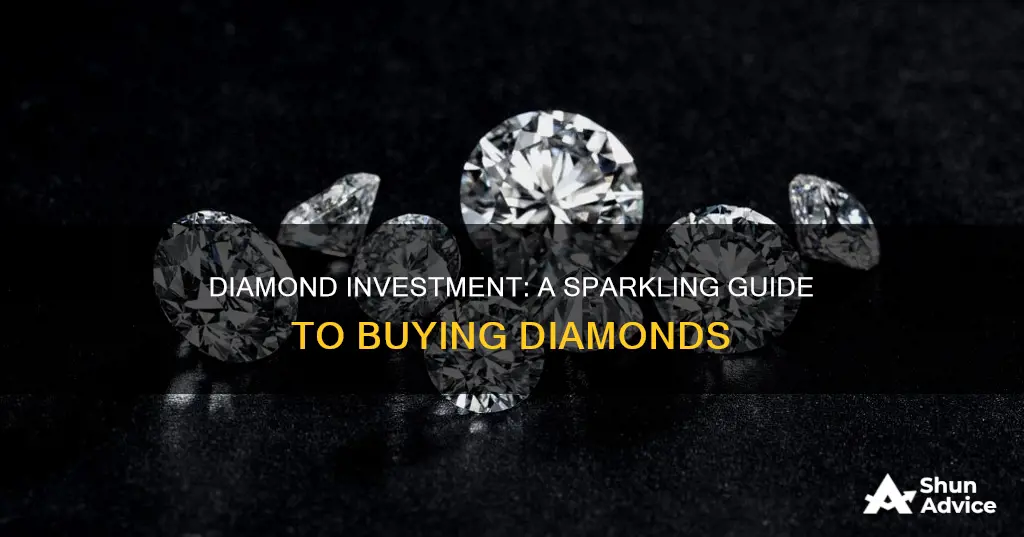
Investing in diamonds can be a tricky business. While diamonds have high intrinsic value, are always in demand, and are small, portable, and easy to store, they have very sketchy investment potential.
Diamonds are a physical commodity, and like other commodities, their value can go down as well as up. They are also subject to fluctuations in price due to fashion and marketing aspects.
However, diamond prices have been more stable than those of other gems, and they have consistently increased over the long term. They are also inflation-proof and durable.
If you are considering investing in diamonds, it is important to do your research and be aware of the potential risks and pitfalls.
What You'll Learn

Understand the 4 Cs: clarity, cut, carat, and colour
Understanding the 4 Cs of diamond grading—cut, colour, clarity, and carat—is essential when buying diamonds as an investment.
Cut
The cut of a diamond might be the most significant factor of the 4 Cs. It determines the diamond's reflective qualities and directly influences its value. A diamond's cut affects its brilliance; the better the cut, the brighter the diamond appears. A well-cut diamond allows light to enter through the table, travel to the pavilion, reflect from side to side, and pour out so the eye can see its fiery brilliance. Poorly cut diamonds have less fire and brilliance, because light enters through the table, hits the facets, and is ultimately lost out of the diamond's sides.
Colour
Diamonds are found with a wide array of colours, from colourless, to faint yellow or even brown, to rare pinks, blues, greens, and other colours known as "fancies". Selecting a diamond colour is a matter of preference. Most diamonds have at least a trace of yellow, brown, or grey body colour. In general, the more colourless a diamond, the greater its relative value. Diamonds that are graded D, E, and F are considered colourless, while diamonds graded G, H, and I are considered near-colourless.
Clarity
Clarity assesses small imperfections within a diamond. Inclusions can occur naturally during the diamond-forming process. Clarity is used to quantify and specify any inclusions. Most diamonds contain very tiny natural characteristics called "inclusions". The size, number, position, nature, and colour of these inclusions (as seen by the trained eye using 10x magnification) will determine a stone's clarity grade. The smaller and less frequent the inclusions and surface blemishes, the more valuable and rare the gemstone.
Carat
Carat measures a diamond's weight. An objective measurement, carat weight is the most popular indicator for showing how large a diamond is. The larger the diamond, the more rare it is. A carat (equivalent to 200 milligrams) consists of 100 points. Therefore, a diamond of 75 points weighs 0.75 carats. It is important to remember that two diamonds of equal carat weight may have dramatically different values, depending upon the stone's cut, clarity, and colour.
Invest Now: Where to Put Your Money
You may want to see also

Set a budget
Setting a budget is an important step in the diamond investment process. Here are some key considerations to keep in mind when determining how much you want to spend:
Firstly, remember that diamond investment should be a part of your overall investment portfolio. While the initial amount required for diamond investment may be higher than some other investments, it is important not to exceed your budget or the allocated ratio within your portfolio.
Next, consider the various costs associated with buying diamonds. Taxes, for example, can significantly impact your investment. Unless you are buying from a non-VAT area, a private seller, or a VAT-registered company, you may be subject to tax, which can reduce your returns. Additionally, there may be retailer markups, so it is crucial to shop around and compare prices to ensure you are getting a competitive deal. Keep in mind that the price of a diamond is influenced by its characteristics, such as carat weight, colour, clarity, and cut, often referred to as the 4 Cs. These factors can impact the value of a diamond, so understanding them can help you make more informed budget decisions.
It is also important to be aware of hidden costs, such as the price of a setting if you choose to have your diamond mounted in jewellery. Insurance is another expense to consider, especially if your diamond is valuable. These additional costs can impact your budget and your overall returns, so be sure to factor them into your calculations.
When setting a budget for diamond investment, it is advisable to seek expert advice. Consult a sophisticated investment diamond advisor who is knowledgeable about diamond quality, international diamond pricing, and market access. This can help ensure that you are making well-informed decisions about when and where to buy and sell your diamonds.
Retirement Reinvented: Navigating Post-Retirement Investment Strategies
You may want to see also

Diversify your diamonds
Diamonds should be a small part of your portfolio. They are an alternative investment, so it's wise to diversify your portfolio by buying more than one diamond. For example, if your diamond investment budget is $20,000, consider buying two diamonds worth $10,000 each, or even split it into three. This will enable you to liquidate a portion of your portfolio if you need to.
Don't buy diamonds of the same type. If you have your heart set on a pink diamond, it might be smart to buy a blue, green, or yellow diamond as your second choice. You don't know which will rise more in value or which will be easier to sell later on.
Buy rare yet desired diamonds. It will be easier to sell a cushion or round cut diamond than a marquise cut. It will also be easier to sell a VS blue diamond than one with I2 clarity. Use common sense and trust your instincts about what to stay away from. Look at the most expensive diamonds for inspiration.
Child's Investment: Building a Home with Mortgage Smarts
You may want to see also

Compare prices
Comparing prices is an essential step when buying diamonds as an investment. The price of a diamond is determined by the 4 Cs: carat, cut, colour, and clarity. The carat weight of a diamond is the most important factor in determining its price. The price per carat is multiplied by the weight of the diamond to get the total price. For example, a 0.50-carat diamond with a price per carat of $4,200 would cost $2,100. The price per carat increases with carat weight, so a 0.74-carat diamond with a price per carat of $7,100 would cost $5,325.
Diamond prices are also influenced by global trends, with the largest markets being the USA, China, and India. Since 2008, larger diamonds have appreciated better than smaller ones. The price of a diamond can also vary depending on its colour, cut, and clarity. For example, a 1-carat diamond can range from $1,500 to more than $16,000, while a 2-carat diamond can cost between $6,000 and $80,000. The price of a diamond can also depend on its shape, with round brilliant cuts being the most expensive.
It is important to compare prices from different retailers to ensure you are getting a fair deal. Online retailers often offer lower prices than brick-and-mortar stores. Websites like Blue Nile, James Allen, and White Flash are recommended for comparing diamond prices. It is also important to consider the certifications of the diamonds when comparing prices, as diamonds with GIA certifications are more valuable than those with EGL/IGI certifications.
Additionally, it is crucial to consider the policies and warranties offered by the jeweller when comparing prices. Factors such as buy-back policies, trade-up policies, free repairs, ring resizing, and jewellery warranties can affect the overall value of the purchase. The location of the purchase can also impact the price, as different countries and states have different laws and sales taxes.
Investing While in Debt: Why You Shouldn't Press Pause on Your Financial Future
You may want to see also

Buy rare yet desired diamonds
When investing in diamonds, it is important to consider the type of diamond you are buying. Rare and desired diamonds are a good investment option. Here are some tips to help you buy rare yet desired diamonds:
- Buy natural diamonds: Natural diamonds are limited in quantity and are formed under unique circumstances over billions of years. Their scarcity contributes to their intrinsic value, and they have demonstrated a trend of increasing in value over time. In contrast, lab-grown diamonds are generally considered less valuable due to their mass production and lack of scarcity.
- Invest in coloured diamonds: Coloured diamonds, such as blue, pink, yellow, or green diamonds, are rare and sought-after. The supply of natural coloured diamonds is limited, and the demand is constantly rising, making them a good investment choice.
- Consider the 4 Cs: When buying diamonds, it is important to understand the four Cs: clarity, cut, carat, and colour. The fewer imperfections a diamond has, the higher its clarity grade. The cut controls its brilliance, so a better cut will result in more sparkle. Carat is a measure of the weight of a diamond, and white or colourless diamonds are generally considered to have the most value.
- Buy certified diamonds: It is important to buy certified diamonds, preferably with a certificate from a reputable laboratory like the Gemological Institute of America (GIA). This ensures that the quality of the diamond is recognised when it comes time to resell.
- Do your market research: Shop around to ensure you're getting value for money. Know your price points in relation to the colour, clarity, cut, and carat weight. Buying at auction can be a good idea as it helps you avoid the margin included in retail prices.
- Consider the long-term nature of the investment: Investing in diamonds is not a get-rich-quick scheme. Diamonds take time to increase in value, and you may need to wait 5-10 years to capitalise on reselling.
The $20,000 Question: Unlocking the Mystery of Investment Growth
You may want to see also
Frequently asked questions
Diamonds are a good investment because they are small, durable, inflation-proof, and easy to store. They have high intrinsic value, are always in demand, and will increase in value over time.
You should invest in natural diamonds as they are limited in quantity and will appreciate in value over time. Lab-grown diamonds, on the other hand, are mass-produced and are therefore less valuable and lower-priced.
When buying diamonds, you should consider the 4 Cs: clarity, cut, carat, and colour. The fewer imperfections a diamond has, the higher its clarity grade. The cut controls its brilliance, so a better cut will result in more sparkle. Carat is a measure of the diamond's weight, and white or colourless diamonds are the most valuable.
There are several risks associated with investing in diamonds, including lack of price transparency, lack of tradability, and the long-term nature of the investment. Diamond prices depend solely on market demand and supply, and buying diamonds is much easier than selling them. Additionally, diamond ornaments are not suitable for quick returns or short-term investments.
One common mistake is expecting too much in the short term. Diamonds increase in value over time and do not offer short-term results. Another mistake is paying too much. It is important to do your due diligence to avoid overpaying. Finally, ensure you only buy certified diamonds to avoid buying the wrong diamond.







